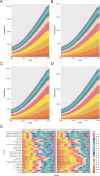The global burden of heart failure attributable to interstitial lung diseases: insights from the global burden of disease study 2021
- PMID: 40189529
- PMCID: PMC11974060
- DOI: 10.1186/s12872-025-04702-y
The global burden of heart failure attributable to interstitial lung diseases: insights from the global burden of disease study 2021
Abstract
Background: The burden of interstitial lung disease (ILD)-associated heart failure (HF) poses a significant challenge to the prognosis of ILD patients. This study aimed to characterize the disease burden and analyse future trends of ILD-associated HF, offering valuable insights to inform targeted prevention and control strategies.
Methods: Data on the prevalence and years lived with disability (YLDs) of ILD-associated HF were retrieved from the Global Burden of Disease (GBD) database for the period 1990-2021. Trends in ILD-associated HF were evaluated using average annual percentage change (AAPC) and percentage change analyses. Future prevalence data were projected up to 2050 using predictive modelling.
Results: Globally, the number of patients with ILD-associated HF increased from 20,229 in 1990 to 104,059 in 2021, with the prevalence rising from 0.53 to 1.41 per 100,000 population. Prevalence rates were disproportionately higher in older populations, with individuals over 95 years experiencing a 17.78-fold increase over the study period. Additionally, a positive correlation was observed between higher socioeconomic development index (SDI) levels and ILD-associated HF prevalence. Among 204 countries, 71.1% exhibited an increasing trend in prevalence. However, Bayesian age-period-cohort (BAPC) modelling predicts a declining trend over the next 28 years.
Conclusion: Over the past three decades, the global burden of ILD-associated HF has escalated, particularly among individuals aged over 65 and in regions with high SDI levels. These findings underscore the need for region-specific, personalized intervention strategies to mitigate disease progression and enhance the quality of life for ILD patients.
Keywords: Global burden of disease; Heart failure; Interstitial lung diseases; Prediction; Prevalence.
© 2025. The Author(s).
Conflict of interest statement
Declarations. Ethics approval and consent to participate: Data from this GBD database are publicly available, and further permission from IHME is not required. Competing interests: The authors declare no competing interests.
Figures





Similar articles
-
Global, regional, and national burdens of heart failure in adolescents and young adults aged 10-24 years from 1990 to 2021: an analysis of data from the Global Burden of Disease Study 2021.EClinicalMedicine. 2024 Dec 9;79:102998. doi: 10.1016/j.eclinm.2024.102998. eCollection 2025 Jan. EClinicalMedicine. 2024. PMID: 39737218 Free PMC article.
-
Global trends in heart failure from 1990 to 2019: An age-period-cohort analysis from the Global Burden of Disease study.ESC Heart Fail. 2024 Oct;11(5):3264-3278. doi: 10.1002/ehf2.14915. Epub 2024 Jun 27. ESC Heart Fail. 2024. PMID: 38937863 Free PMC article.
-
Burden of disease scenarios for 204 countries and territories, 2022-2050: a forecasting analysis for the Global Burden of Disease Study 2021.Lancet. 2024 May 18;403(10440):2204-2256. doi: 10.1016/S0140-6736(24)00685-8. Lancet. 2024. PMID: 38762325 Free PMC article.
-
Global and China trends and forecasts of disease burden for female lung Cancer from 1990 to 2021: a study based on the global burden of disease 2021 database.J Cancer Res Clin Oncol. 2025 Feb 8;151(2):68. doi: 10.1007/s00432-025-06084-2. J Cancer Res Clin Oncol. 2025. PMID: 39921760 Free PMC article. Review.
-
Global, regional, and national burden of asthma and atopic dermatitis, 1990-2021, and projections to 2050: a systematic analysis of the Global Burden of Disease Study 2021.Lancet Respir Med. 2025 May;13(5):425-446. doi: 10.1016/S2213-2600(25)00003-7. Epub 2025 Mar 24. Lancet Respir Med. 2025. PMID: 40147466
References
-
- Wijsenbeek M, Suzuki A, Maher TM. Interstitial lung diseases. Lancet. 2022;400:769–86. - PubMed
MeSH terms
Grants and funding
LinkOut - more resources
Full Text Sources
Medical
Research Materials
Miscellaneous

